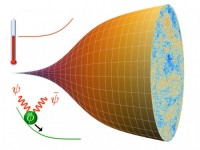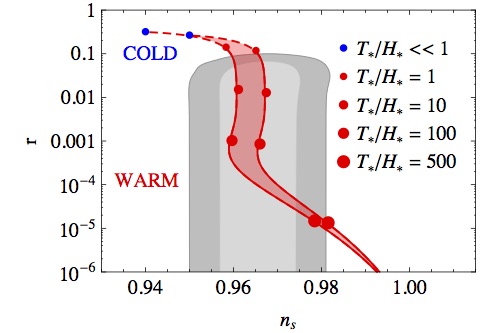Alternative scenario of early Universe overcomes significant theoretical hurdle.

Warm inflation is an alternative and simpler dynamical picture for the the early Universe, in which the dominant expansion period occurs in a warm phase, whereas in the standard inflation picture, accepted for over three decades, it occurs in a cold phase. This leads to distinct differences in the history of the early Universe and present-day observational signatures.
For over the two decades since warm inflation was suggested by Arjun Berera, experts in the fields of cosmology and particle physics have regarded it as almost impossible to realize this idea in a simple first principles model. This paper has confounded these expectations and developed a simple and compelling first principles model of warm inflation. This now provides a solid theoretical foundation to an alternative paradigm for the early Universe, which shows excellent agreement with large scale observational data (see figure below).

In standard inflation, any preexisting radiation is stretched and dispersed during a brief cosmic phase and no new radiation is produced. The Universe’s temperature plummets by several orders of magnitude, and an ensuing reheating period fills the Universe with radiation again. Warm inflation is simpler. New radiation is constantly produced by the decay of the scalar field that triggers inflation, the inflaton; the temperature remains large; and there is no reheating phase. Ironically, however, models of warm inflation have so far required thousands of additional fields to be coupled to the inflaton to avoid large corrections to its mass.
This paper treats the field driving inflation as a pseudo Nambu-Goldstone boson of a broken gauge symmetry and its mass is naturally protected against large quantum and thermal corrections. The model is similar to the Little Higgs mechanism for electroweak symmetry breaking. Using this idea Berera and colleagues built a model involving only four additional fields and no mass corrections. The researchers then compared the model’s observational predictions with constraints on inflation derived from Planck satellite measurements of the cosmic microwave background radiation and found good agreement between the two. The presence of radiation during inflation has been known from very earlier work by Berera and colleagues to lower the tensor-scalar ratio. This model realises this result in a compelling first principles model, thus accommodates the possibility for a tensor mode anywhere from the present upper bound to a value extremely below that.
The latest research is published in Physical Review Letters and was highlighted by the journal as an Editors' Suggestion, which recognises its important contribution to the field.

